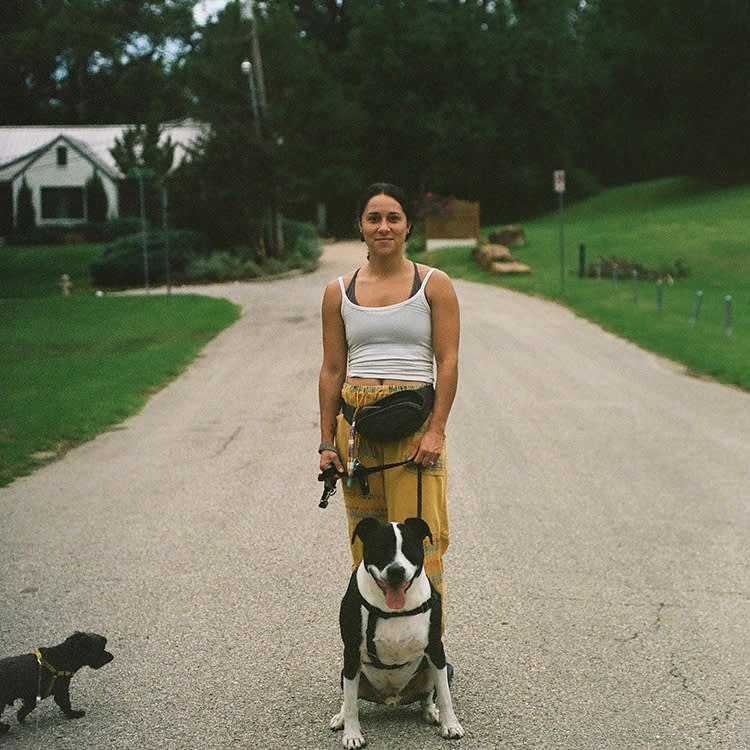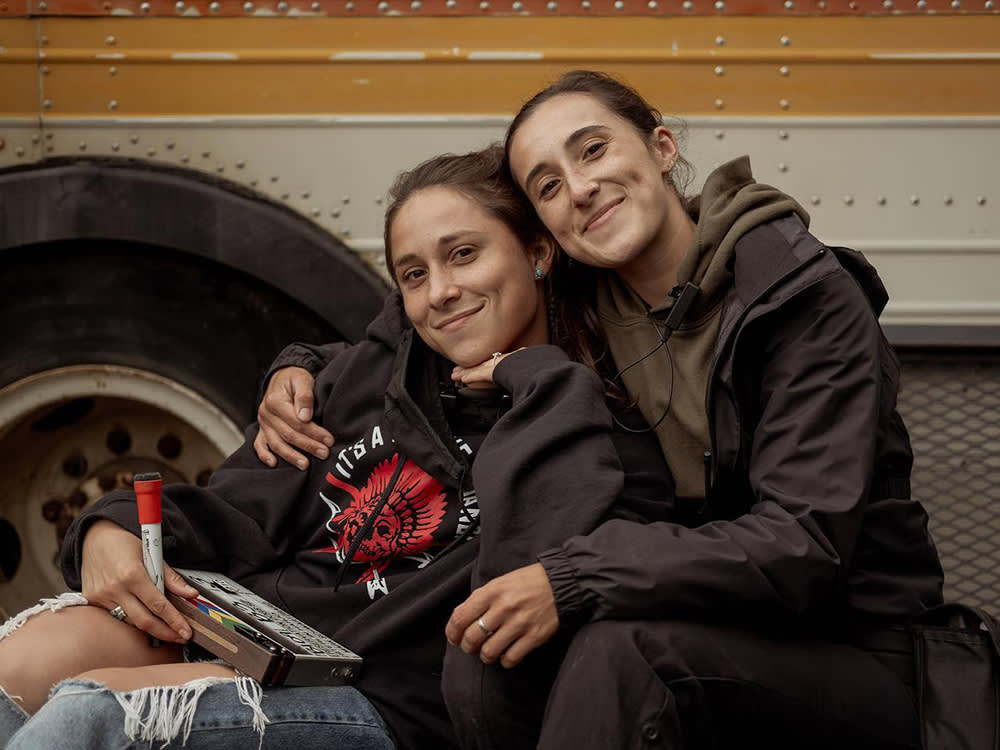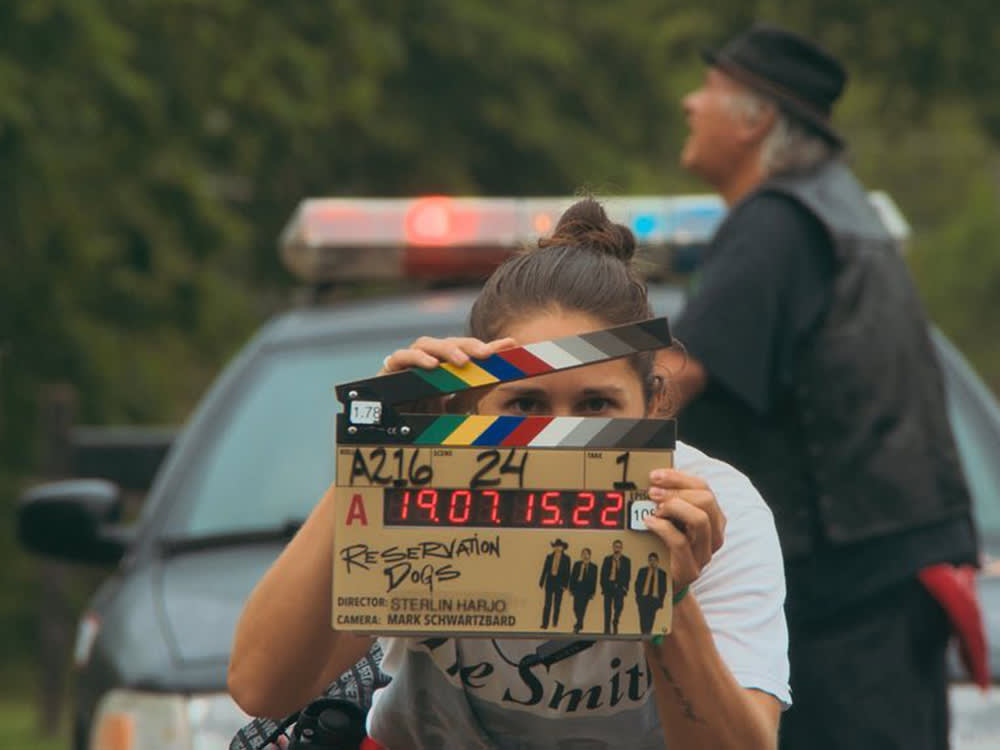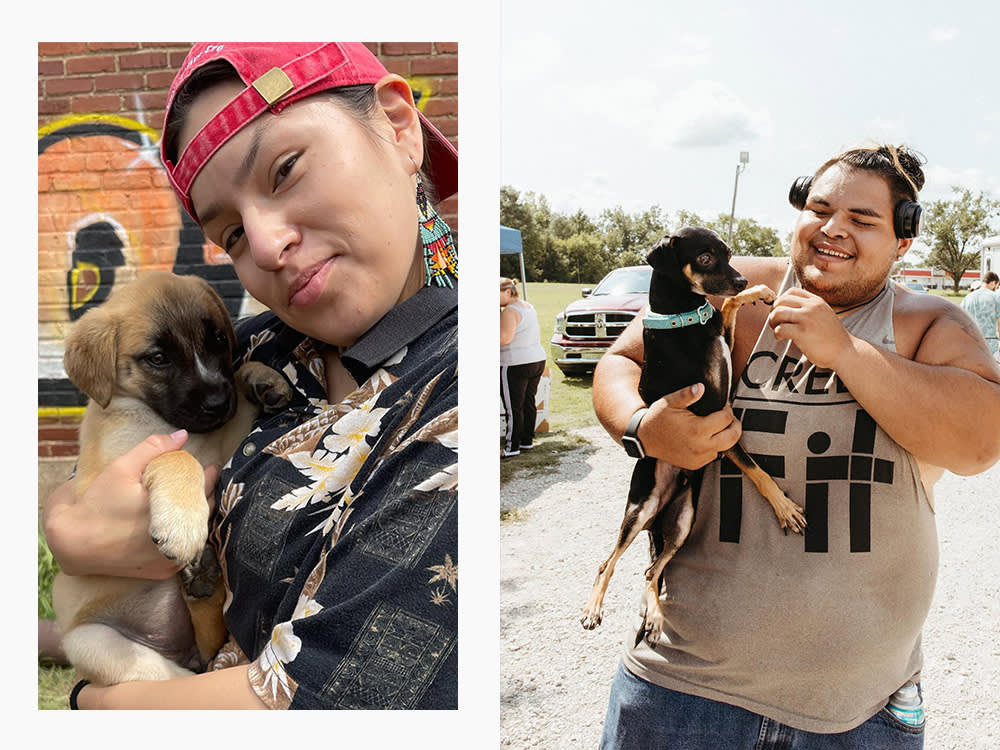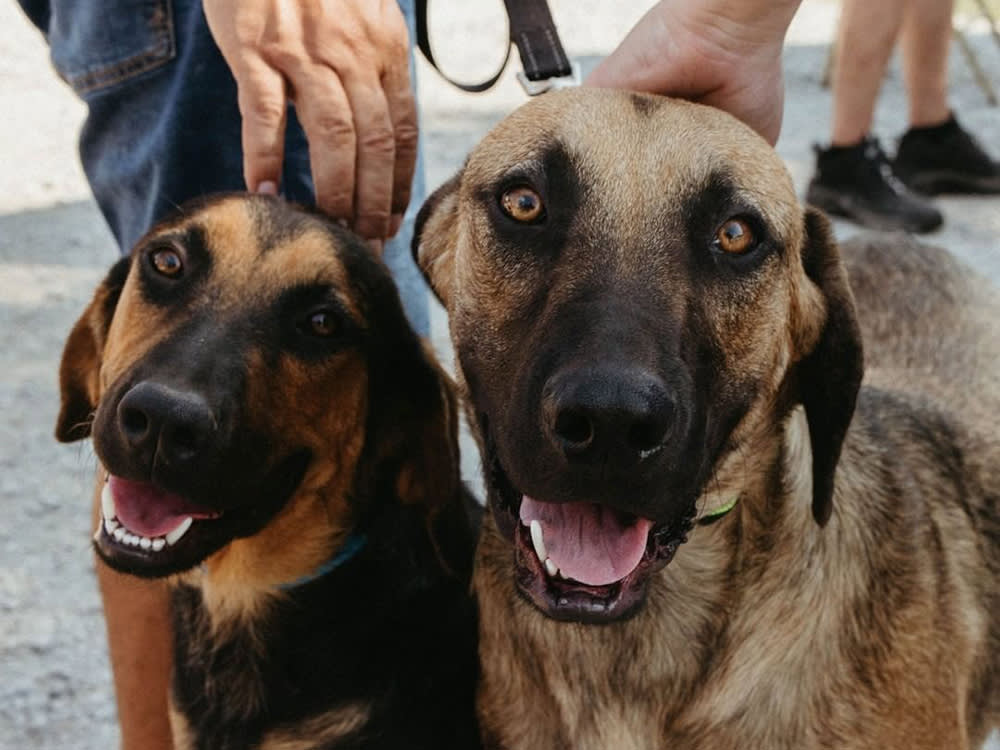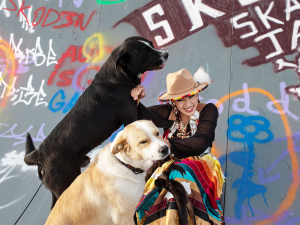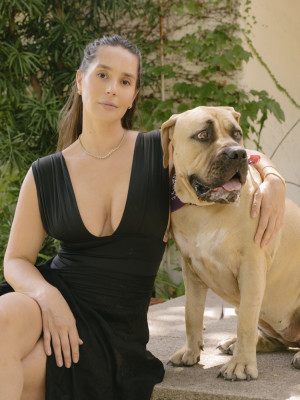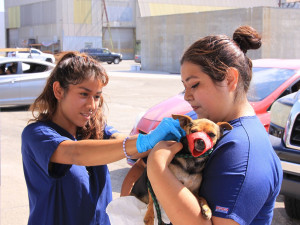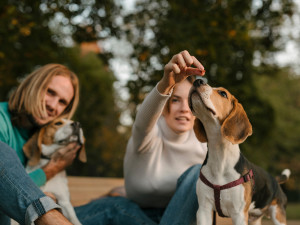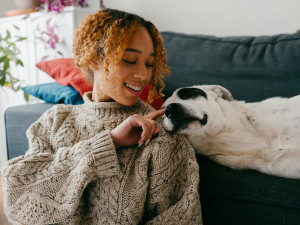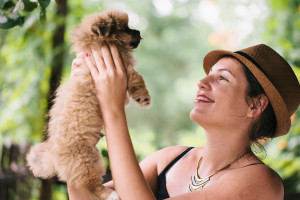How the “Reservation Dogs” Set Became a Makeshift Oklahoma Dog Rescue
Filmmakers Brit and Taylor Hensel on their side hustle to save real life “rez dogs.”
While working in the camera department for FX’s Reservation Dogsopens in new tab, Brit opens in new tab and Taylor Henselopens in new tab noticed the outsize number of stray dogs wandering around where they shot in Tulsa, Oklahoma. The sisters, who are filmmakers in their own right, are members of Cherokee Nation and wanted to give back to the tight-knit local community that supports their work. It all started with those pups they’d see on set.
“There are 39 federally recognized tribes in Oklahoma, one of the highest numbers in any state. Almost any tribe that lives in Oklahoma today was forcefully moved here. Everybody has their own Trail of Tears story,” Brit explains. “You drive 20 minutes in any direction, and you’re in a new tribal territory — different languages, different customs, different foods. But there’s this shared communal understanding between people here, which really rocks.”
Trick question: All dogs are perfect! But find out which type is the best fit for you.
Embracing that ethos, the sisters recruited series co-creator Sterlin Harjo and countless Reservation Dogs crew members to form a makeshift animal rescue, dubbed Rez Dog Rescue. Partnering with the Tulsa SPCAopens in new tab, they’re not only saving strays but also providing support to the area’s low-income pet parents.
Kinship spoke with Brit and Taylor to learn more about their powerful extracurriculars, which sit at the intersection of social justice and grassroots activism.
How much do you spend on your pet per year?
How did you get started?
Brit: While we were on set, we were like “Man, there’s so many strays.” Me and Taylor were like, “What’s the best way we can help here?” Being in the camera department is really awesome. But we were running this side hustle during season two the whole time. “There’s a dog over here! What’s the plan? What do we do?”
Taylor: It was a team effort. The whole crew, people from every department, were pitching in anytime we found an animal in need.
Brit: Traditionally, animals have a very special place in our culture. Most of the stories and the lessons we were taught come in the form of animal stories, akin to parables. So animals are great teachers.
Can you explain the need for this type of help in and around reservations?
Brit: We do have a unique struggle as Native people, because there is a lot stacked against us in terms of access to resources and support. People are working hard to just make stuff happen in their daily lives, and animals can sometimes fall through the cracks of that. The cool part about the show is it’s really community rooted. It’s, like, people’s aunties and uncles within this neighborhood. They’re allowing us into their space to shoot. So a natural inclination is to be, like, “What can we do to help make people feel supported, and to show our care for where we are?” We ended up saving 14 animals on season two.
Can you speak about the obstacles that are somewhat unique to Tulsa?
Brit: Oklahoma is one of the worst places to be a dog or a cat. The oil and gas industry is everything here. And it also kind of butts up against the meat-processing industry, which weakens our laws in terms of how domestic companion animals are treated. We have a huge gap into how to protect companion animals when the laws are murky on how to treat cows, cattle, livestock.
Like, the law for animals is that they need to have shelter and water. But the law doesn’t explain what is considered decent shelter. Money rules here. Big industry rules. As long as people are able to slaughter cattle to work in the meat industry here, they aren’t thinking about the trickle-down effect. There’s people here doing the rescue work on foot, and then there are people who are trying to get into the legislative fight. We’ve been doing animal work for a long time on our own. It can really make you feel buried, because the problem is so vast.
How are you financing all this?
Brit: Me and Taylor first started paying for it ourselves. It is around $750 per animal. We messaged the SPCA, because we heard they had dogs in their shelter named after Reservation Dogs characters. We also started there because they’re one of the big hitters here in Oklahoma. On set, we were like, “Alright, let’s do $5 Fridays,” and all the money will go to helping get dogs into the shelter. We made around $2,200.
How are you able to work and rescue animals at the same time?
Taylor: The locations team on set was a huge help. Basically, they know all the properties really well and make relationships with the people in the neighborhoods and locations. Rocky Harjo was a huge help — he’s Sterlin’s brother. He’s a huge animal lover. The locations folks usually find the animals first.
We had a group chat, and we’d be like, “Alright, found another one. What can we do?” We had, you know, supplies on set and in our trunks. We had leashes, collars, dog food. At one point, we had an animal wrangler on set who would help. Whoever found the animal would triage it. We would call the SPCA and be like, “Hey, we found another one. Do you have a spot for it today?” And they would usually say yes, and then we’d figure how to get them there.
Who’s adopting them after that?
Brit: We don’t have access to that info, but it’s mostly in-state. Once we get them to Tulsa SPCA, they become totally in their care. So that’s when we let go. We’ll get updates and see their progress. We did have some animals in really bad shape. It was just beautiful to see how they’ve healed.
Could you describe the shape in which you found some animals?
Brit: Yeah, there was one dog that had a really terrible case of mange, which is kind of like flesh-eating bacteria. This dog was very young, not even a year old. So covered in sores, he physically couldn’t stand. When one of our crew members found him, they thought he was dead. It turns out he wasn’t. His legs were really swollen and just kind of oozing everywhere. The pup is totally healed, with, like, a silky coat.
Which breeds do the dogs out there tend to be?
Brit: Pit Bull types. A lot of mixed breeds. It’s very hard to pinpoint what they are, but they’re on the bigger side. We didn’t find any really tiny dogs.
How are the local indigenous people responding to this?
Brit: Sterlin and his company, Crazy Eagle Media, have been our largest funders. We want to work with the tribes as tribal people. We want to take care of our communities. I had begun conversations with Cherokee Nation to figure out if they would be interested in some sort of program where we support local citizens. Now, with Sterlin Harjo, I have a connection to Muskogee people there. We wanted to start with the tribes in Tulsa first.
Have you continued these efforts after season two stopped shooting?
Brit: We actually just did a mobile clinic! We just want to create an opportunity to give back, so we partnered with Tulsa SPCAopens in new tab. We bought one of their mobile units out.
We sent fliers to residents, the neighborhoods, and went door to door and were like, “Hey, on this day, we’ll be offering flea and tick preventatives, spay/neuter surgeries on site, grooming... We’re gonna help with fence-building, heartworm testing.” We have ramps and gates and, like, cat scratchers and toys. It was really wild because the smiles and the gratitude were, like, palpable. They’ve been so gracious to let us shoot in their space for two years now.
Was it difficult for you both to connect with the SPCA?
Brit: Not at all. Taylor used to work for the Humane Society. The perspective she got really opened my eyes to how the rescue world works.
Taylor: There’s such a need for people to do something, to just try. The Tulsa SPCA team was so excited that Brit and I were down to do the work and figure it out. And they have such a professional infrastructure. They’re such a powerhouse here in our community. And they were able to, you know, set the scene for us to get in there and do the work and bring everyone together. And it was a welcome request for them.
When I interviewed Paulina, she mentioned she brought her pregnant dog to set. And she was essentially a doula to the dog. Were you there for that?
Brit: I talked to her about that. I’d be like, “What’s going on with the dogs? What do you need? Do we need to get to Tulsa SPCA?” But Paulina was like, “I’ve done this so many times. So I really am totally fine.”
She did a great job. She found homes for them while she was here. I think her mom came down, and her boyfriend was here. So she had some help and the supplies she needed. Everybody was really paying attention to make sure she was okay. But Paulina always makes it happen.
What are some of some of your goals in the future?
Brit: I think the biggest hurdle is access to resources. I envision a fleet of mobile units that can go out and support people where they need help. Partnering with tribes would be something that I would really like to make happen, to sort of create an infrastructure. We’re not trying to invent something from the ground up. We’re trying to harness the resources. The mobile clinic that we just did was such an amazing example. If we could have those more frequent frequently, it would make a huge difference.
Donate to the Tulsa SPCA hereopens in new tab:
